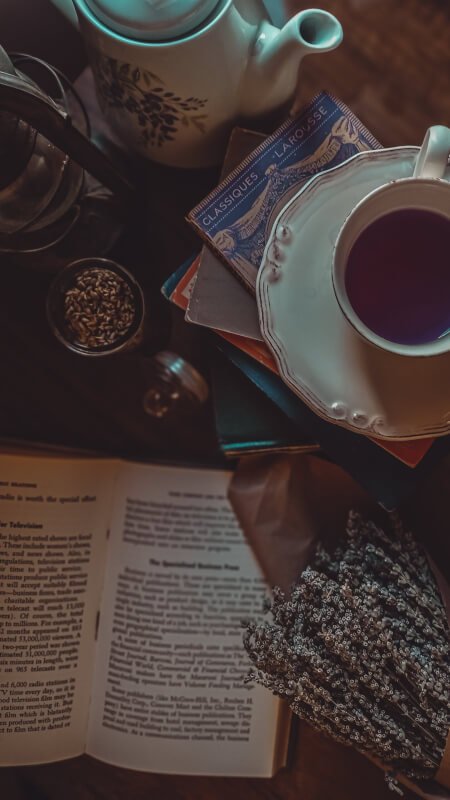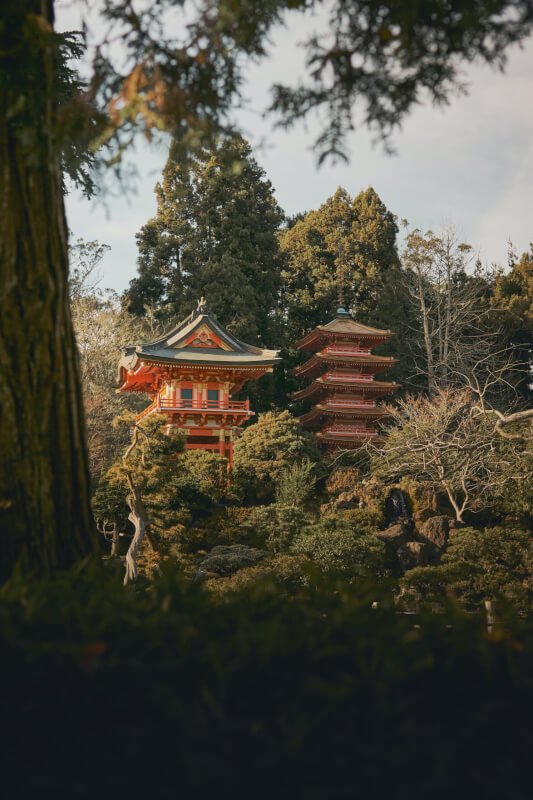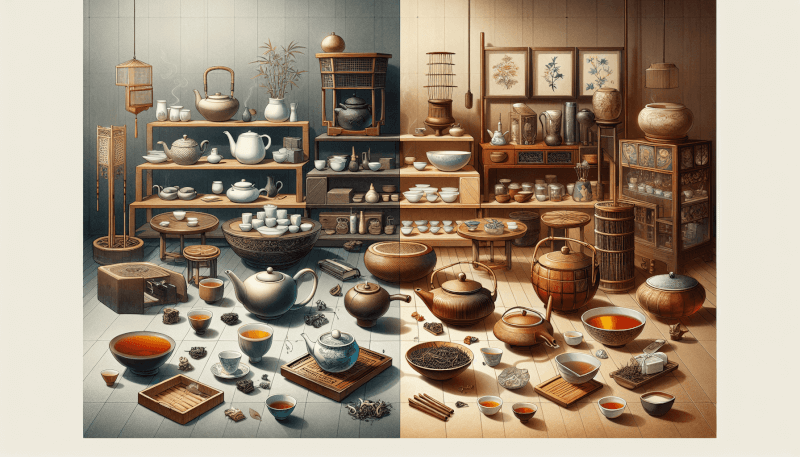Step into the enchanting world of tea brewing as you embark on a delightful journey through the captivating realms of traditional versus modern teahouses. Discover the centuries-old techniques passed down through generations as you witness the artistry and precision of tea masters in traditional teahouses. Alternatively, experience the fusion of tradition and innovation as contemporary teahouses bring forth a fresh approach to tea brewing, blending ancient practices with modern conveniences. Whether you seek the tranquility of tradition or crave the excitement of innovation, this article will unveil the secrets behind the art of tea brewing in both traditional and modern teahouses.
Traditional Teahouses
Teahouses have a long and rich history, deeply rooted in Eastern cultures such as China and Japan. These traditional establishments are more than just places to enjoy a cup of tea; they hold significance as cultural and social spaces. Traditional teahouses have been an integral part of society for centuries, and their history and traditions are worth exploring.
History and Tradition
Traditional teahouses have a storied past, originating in ancient China during the Tang dynasty. Tea was closely associated with spirituality, health, and social interactions. As tea cultivation and appreciation spread across Asia, teahouses became popular gathering places for intellectuals, artists, and scholars. They were not merely tea-serving establishments; they were hubs of intellectual and artistic exchange.
Tea Ceremony
One of the most fascinating aspects of traditional teahouses is the tea ceremony. These rituals, often steeped in history and tradition, serve as a way to appreciate and honor the art of tea brewing. The tea ceremony involves precise movements and gestures, symbolizing harmony, respect, and tranquility. Each step of the ceremony is carefully executed, from the washing of the teaware to the proper way of pouring and serving the tea. Attending a tea ceremony in a traditional teahouse is an immersive experience that transports you to a different time and place.
Tea Brewing Techniques
Traditional teahouses place great importance on the technique of tea brewing. Mastering the art of brewing tea involves understanding the intricacies of water temperature, tea leaf quality, and brewing time. In traditional teahouses, specific techniques such as steeping tea leaves in a Gongfu style or using a traditional Yixing clay teapot are often employed to bring out the best flavors and aromas of the tea. These techniques have been passed down through generations, ensuring that the tea-drinking experience is nothing short of exceptional.
Tea Utensils and Equipment
In traditional teahouses, the selection of tea utensils and equipment is a crucial aspect of the tea experience. From elegant teacups and teapots to beautifully crafted bamboo tea trays and tea scoops, every piece of teaware is carefully chosen to enhance the tea-drinking experience. These utensils also hold symbolic meaning and reflect the cultural heritage associated with tea. Traditional teahouses take pride in their curated collection of teaware, creating an ambiance that transports customers to a bygone era.
Modern Teahouses
While traditional teahouses continue to thrive, modern teahouses have emerged as a result of cultural evolution and changing lifestyles. These contemporary establishments aim to blend tradition with innovation, creating a unique tea experience for a new generation of tea enthusiasts.
Evolution and Innovation
Modern teahouses represent a departure from the strict adherence to traditional tea ceremonies. Instead, they embrace a more relaxed and accessible approach, making tea brewing a creative and interactive process. Innovation in tea brewing techniques, such as cold brewing or artisanal blends, allows for a broader range of flavors and styles, appealing to a diverse customer base. Moreover, modern teahouses often adopt modern technology and equipment to streamline the tea brewing process, catering to the fast-paced lifestyle of today’s society.
Tea Vessels and Brewing Methods
In contrast to traditional teahouses, modern teahouses showcase a range of tea vessels and brewing methods that cater to different tastes and preferences. From glass teapots that allow the colors and shapes of the tea leaves to shine through to automated brewing machines that ensure consistency, these teahouses prioritize convenience and efficiency. While some may argue that this departure from tradition sacrifices the artistry of tea brewing, modern teahouses provide a gateway for individuals to explore and experiment with various brewing techniques.
Focus on Aesthetics
One striking aspect of modern teahouses is their emphasis on aesthetics. These establishments often boast contemporary, minimalist designs that create a visually captivating environment. The presentation of tea is treated as an art form, with attention given to the color, texture, and arrangement of the tea leaves and accompanying accessories. By integrating design elements, modern teahouses offer a sensory experience that appeals to both tea enthusiasts and those seeking Instagram-worthy moments.
Tea Education and Exploration
Modern teahouses go beyond the simple act of tea brewing and consumption. They place great importance on tea education, providing workshops, tasting sessions, and even certification programs for those interested in delving deeper into the world of tea. With a focus on education, modern teahouses foster a sense of exploration and self-discovery, empowering individuals to make informed choices based on their own preferences. This emphasis on tea knowledge allows customers to develop a deeper appreciation for the art of tea brewing.

Differences Between Traditional and Modern Teahouses
While both traditional and modern teahouses share a common goal of promoting the joy of tea, there are distinct differences that set them apart. These differences encompass various aspects, including approach to tea brewing, presentation and serving, interactions and atmosphere, as well as tea selection and menu offerings.
Approach to Tea Brewing
Traditional teahouses adhere to time-honored brewing techniques, emphasizing precision and mastery. The focus is on extracting the true essence of the tea, often using small teapots and multiple infusions to achieve a well-rounded flavor profile. On the other hand, modern teahouses take a more flexible approach, encouraging creativity and exploration through variations in brewing methods, such as cold brewing, blending teas, or experimenting with tea-infused cocktails.
Presentation and Serving
In a traditional teahouse, presentation and serving are integral components of the tea experience. Tea is served in carefully selected teaware, with meticulous attention paid to every detail. Traditional rituals, such as the use of fragrance cups or pouring tea from an elevated height, hold symbolic meaning and contribute to the overall atmosphere. In contrast, modern teahouses focus on creating visually stunning presentations that are more aligned with contemporary aesthetics, often incorporating elements of latte art or floral arrangements.
Interactions and Atmosphere
Traditional teahouses are renowned for their tranquil and serene ambiance, providing a space for introspection and meaningful conversations. The focus is on creating an atmosphere conducive to relaxation and contemplation. While modern teahouses also strive to create a welcoming environment, their emphasis is on fostering social interactions and a sense of community. These establishments encourage customers to engage in lively conversations, participate in tea tastings, or attend events that promote tea appreciation.
Tea Selection and Menu
Traditional teahouses tend to offer a narrower range of teas, often focusing on single-origin, high-quality teas that adhere to strict brewing traditions. The emphasis is on preserving and showcasing the authenticity of the tea. In contrast, modern teahouses offer a broader selection, including flavored teas, herbal blends, and imaginative tea-infused creations. These establishments cater to varying tastes, offering tea options that may appeal to those seeking unique and unconventional flavors.
Benefits and Drawbacks of Traditional Teahouses
Traditional teahouses have a distinct charm and allure that continue to attract tea enthusiasts. However, they also come with inherent advantages and disadvantages.
Preservation of Culture and Heritage
Traditional teahouses play a vital role in preserving the cultural heritage associated with tea. They serve as guardians of tradition, passing down generations of knowledge, rituals, and brewing techniques. By immersing oneself in a traditional tea experience, one gains a deeper understanding of the historical significance and reverence for tea. These teahouses act as cultural ambassadors, maintaining the authenticity of tea brewing as it has been for centuries.
Sense of Authenticity
Stepping into a traditional teahouse evokes a sense of timelessness and authenticity. The carefully crafted ambiance, elegant teaware, and adherence to age-old rituals transport visitors to a world where tea is more than a beverage – it is an art form. Traditional teahouses provide an escape from the modern world, allowing individuals to immerse themselves in a slower pace and appreciate the simplicity and beauty of tea.
Limited Accessibility
While the exclusivity of traditional teahouses adds to their charm, it also limits accessibility for many individuals. These establishments often require reservations and may have strict protocols for attending tea ceremonies. Additionally, the cost associated with the traditional teahouse experience can be prohibitive for some. This exclusivity may prevent individuals from fully experiencing the cultural significance of tea or exploring the art of tea brewing in-depth.
Narrow Tea Choices
Traditional teahouses typically offer a limited selection of teas, focusing on refined, single-origin options. While this approach maintains the integrity of traditional brewing methods, it may not cater to the diverse tastes and preferences of a broader audience. Individuals with a desire to explore different tea types or experiment with unique flavors may find the traditional teahouse experience somewhat restrictive.

Benefits and Drawbacks of Modern Teahouses
With the rise of modern teahouses, there are distinct advantages and disadvantages presented by these contemporary establishments.
Adaptation to Modern Lifestyles
Modern teahouses offer a refreshing approach tailored to the fast-paced lifestyle of today’s society. The flexibility in brewing techniques, such as using tea bags or offering ready-to-drink options, caters to individuals seeking convenience without compromising the quality of their tea. Moreover, the incorporation of technology, such as automated brewing machines, ensures consistency and efficiency, making tea accessible to a wider audience.
Expanding Tea Options
Modern teahouses open up a world of tea exploration, introducing a myriad of flavors, blends, and infusions. These establishments embrace innovation, creating unique tea concoctions that marry traditional brewing methods with contemporary trends. Whether it’s a matcha avocado smoothie or a lavender-infused oolong blend, modern teahouses push the boundaries of tea, inspiring individuals to broaden their horizons and discover new favorites.
Lack of Traditional Elegance
While modern teahouses offer a refreshing take on tea brewing, some argue that they lack the elegance and sophistication found in traditional teahouses. The focus on aesthetics and innovative presentation may overshadow the true essence of tea and its intricate brewing techniques. The art of tea can be overshadowed by the desire to create visually striking experiences, potentially diluting the importance of the tea itself.
Potential Commercialization
As modern teahouses cater to a broader market and aim to appeal to a larger audience, there is a risk of commercialization. The demand for quick and convenient options may result in the mass production of teas or the use of low-quality ingredients. Commercialization could shift the focus away from the artistry and craftsmanship that defines traditional tea brewing, potentially compromising the quality and authenticity of the tea experience.
The Role of Experience in Tea Brewing
Tea brewing is an art that requires continuous learning, practice, and exploration. Both traditional and modern teahouses contribute to the cultivation of this art form, each offering unique opportunities for individuals to enhance their understanding and appreciation of tea.
The Importance of Mastery
In traditional teahouses, the emphasis on mastery is paramount. It takes years of dedication and practice to perfect the delicate balance of factors that influence the flavor and quality of brewed tea. By immersing oneself in the traditional tea ceremony and learning from experienced tea masters, individuals gain insights into the intricacies and nuances of tea brewing. Mastery comes not only from theoretical knowledge but also from practical experience and a deep connection with the art of tea.
Learning from Experts
Traditional teahouses provide a valuable opportunity to learn directly from tea experts. These establishments often have experienced tea masters who guide individuals through the various stages of tea brewing, sharing their wisdom and expertise. Observing and learning from these experts allows aspiring tea enthusiasts to develop their own brewing skills and gain a more profound understanding of the art of tea.
Innovation and Self-Exploration
Modern teahouses encourage individuals to embark on their own tea exploration journey. By providing a range of tea options and brewing methods, these establishments empower tea enthusiasts to experiment, customize, and invent their unique tea experiences. Innovation plays a significant role in modern teahouses, fostering creativity and self-expression. Through self-exploration, individuals can develop their own brewing techniques, discover new flavor combinations, and push the boundaries of tea craftsmanship.
Balancing Tradition and Modernity
Tea brewing is not a choice between tradition and modernity; it is a delicate balance between the two. Recognizing the value of both traditional and modern approaches allows tea enthusiasts to appreciate the richness and diversity of tea culture. By weaving ancient rituals with innovative brewing techniques, individuals can create their personalized tea experience while honoring the authenticity and heritage of tea.

Implications for Tea Industry
The coexistence of traditional and modern teahouses has significant implications for the tea industry as a whole. Their diverse approaches to tea brewing and service create opportunities and challenges that shape market trends, consumer preferences, and tea culture as a whole.
Market Trends and Consumer Preferences
The rise of modern teahouses reflects a shift in consumer preferences and lifestyle choices. As individuals seek convenience, innovation, and a wider range of tea options, the demand for modern teahouses is expected to rise. Traditional teahouses, meanwhile, continue to attract those who prioritize authenticity, tradition, and a deeper connection with tea culture. Recognizing and catering to these differing preferences are crucial for tea businesses to thrive in an evolving market.
Competition and Coexistence
The coexistence of traditional and modern teahouses fosters healthy competition. This competition encourages continuous improvement, innovation, and the elevation of tea both as a craft and a commodity. Traditional teahouses can learn from modern teahouses’ ability to cater to changing consumer demands, while modern teahouses can draw inspiration from the rich history and time-honored practices of their traditional counterparts. By complementing each other’s strengths, these two approaches can coexist and contribute towards a thriving tea industry.
Influence on Tea Culture
Traditional and modern teahouses shape the trajectory of tea culture in different ways. Traditional teahouses serve as the guardians of tea tradition, preserving cultural heritage and ensuring the longevity of centuries-old rituals. By upholding the art and authenticity of tea, these establishments lay the foundation for the future of tea culture. On the other hand, modern teahouses help redefine tea culture by introducing new flavors, brewing techniques, and engaging experiences. They attract a wider audience to tea, expanding its appeal and reimagining its role in contemporary society.
Globalization and Fusion
The emergence of both traditional and modern teahouses has been further accelerated by globalization. As tea transcends geographical barriers, cultural influences merge, creating unique fusion tea experiences. Traditional tea ceremonies may incorporate modern serving techniques, while modern teahouses may pay homage to traditional brewing methods. This fusion of cultural elements contributes to the diversity and dynamic nature of the tea industry, enriching tea culture as it continues to evolve.
Indulging in Tea Culture: Traditional vs. Modern Approach
When it comes to indulging in tea culture, individuals have the opportunity to explore both the traditional and modern approaches. Each approach offers distinct qualities and experiences, presenting a range of pleasures for tea enthusiasts.
Exploring Authenticity and Ritual
For those drawn to the traditions and history of tea, the traditional teahouse experience provides a unique opportunity to engage in authentic tea rituals. The deliberate, careful movements and the serene ambiance create a setting for introspection, mindfulness, and a deep appreciation for the art of tea brewing. Traditional teahouses allow individuals to be transported back in time, experiencing tea in a way that connects them to generations past.
Appreciating Innovation and Creativity
On the other hand, modern teahouses encourage individuals to embrace innovation and creativity. These establishments offer opportunities to expand one’s palate and explore unconventional flavor combinations. From tea lattes to tea-infused desserts, modern teahouses inspire individuals to view tea as a versatile ingredient that can be incorporated into various culinary creations. By appreciating the fusion of flavors and techniques, tea lovers can unlock new dimensions of tea enjoyment.
The Future of Tea Houses
Moving forward, the future of tea houses lies in embracing diversity, maintaining a delicate balance between tradition and innovation. Both traditional and modern teahouses have their place in the tea industry, catering to different tastes, preferences, and lifestyles. The key lies in recognizing the unique strengths of each approach and adapting to meet the evolving needs of tea enthusiasts.
Personal Preferences and Choices
Ultimately, whether you gravitate towards traditional teahouses or modern teahouses depends on your personal preferences and choices. Some individuals may find solace and inspiration in the tranquil atmosphere and rich history of traditional teahouses. Others may be captivated by the aesthetic presentation and contemporary flair of modern teahouses. The tea world is vast and diverse, offering something for everyone, and it is through personal exploration and discovery that the true magic of tea can be experienced.

Conclusion
Exploring the art of tea brewing in traditional and modern teahouses is an invitation to embark on a sensory journey. Traditional teahouses offer a glimpse into the past, preserving cultural heritage and time-honored traditions. Modern teahouses, on the other hand, provide a canvas for creativity and innovation, inspiring tea enthusiasts to push boundaries and reimagine the possibilities of tea. Both approaches have their merits and drawbacks, presenting unique experiences that cater to different preferences and aspirations.
As the tea industry continues to evolve, the coexistence of traditional and modern teahouses will shape the future of tea culture. Each approach influences market trends, consumer preferences, and the wider perception of tea as an art form. Embracing this diversity in tea brewing allows for an ever-expanding tea world, where the exploration of flavors, techniques, and tea culture is limitless.
So, whether you find solace in a traditional teahouse’s serene ambiance or delight in the vibrant creativity of a modern teahouse, the art of tea brewing awaits, ready to transport you to new horizons of taste, knowledge, and appreciation. The choice is yours to make, but remember, the true joy of tea lies in the journey itself – a journey that never ends but only continues, fueled by an insatiable thirst for knowledge, discovery, and the love of tea. So, take a sip, and let the exploration continue.

